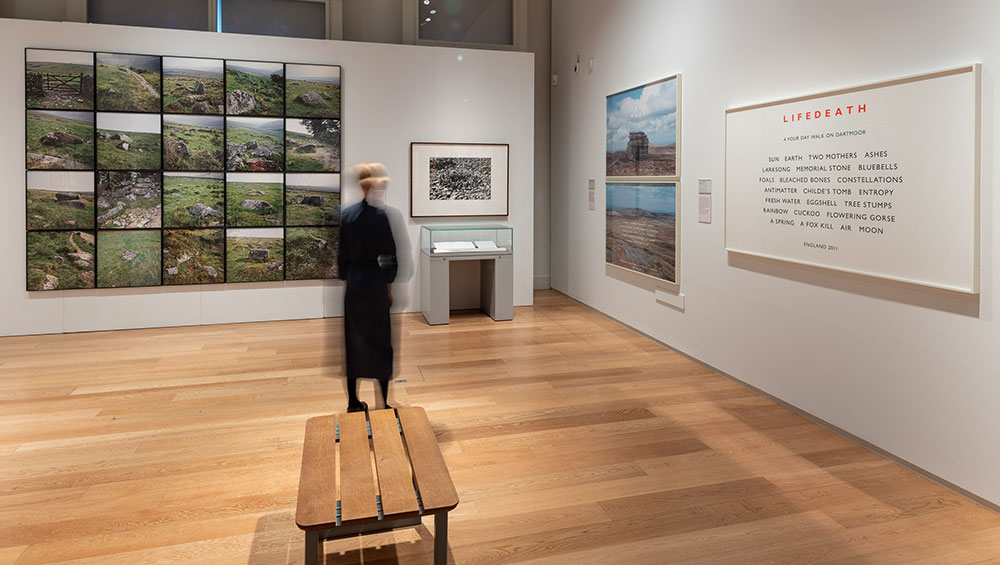
Dartmoor: A Radical Landscape, Royal Albert Memorial Museum and Art Gallery, Exeter, 19 October 2024 – 23 February 2025. Photo: Simon Tutty.
Royal Albert Memorial Museum and Art Gallery, Exeter
19 October 2024 – 23 February 2025
by BETH WILLIAMSON
Dartmoor is a place long steeped in myth and magic. It is a place that has always attracted artists and inspired their life and work. Navigating the ancient landscape can be physically and psychologically challenging. Representing that landscape with any real integrity in a museum is perhaps a greater challenge still. Yet that is precisely what this exhibition does. Showing the work of 20 artists and photographers from 1969 until the present day, A Radical Landscape presents photography, film and land art that engages directly with the freedom and wilderness of Dartmoor as well as with the current issues of ecology, climate and land access.
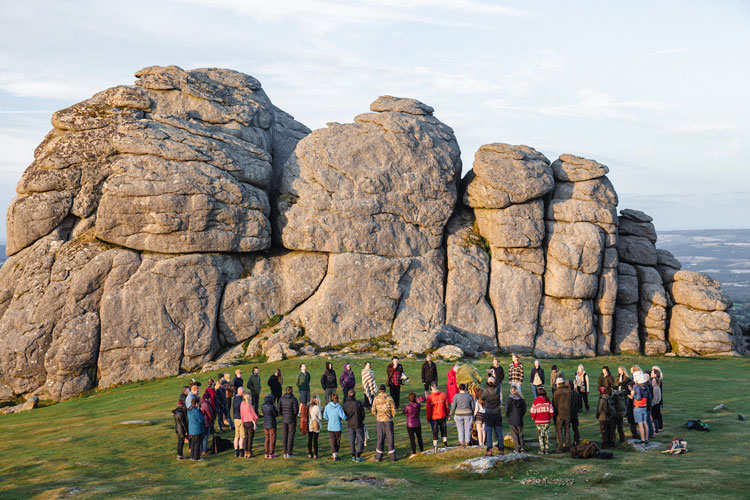
Fern Leigh Albert, Circle of Protest Haytor, 2023. (Dartmoor, RAMM, Exeter, 2024). © Fern Leigh Albert.
With a wealth of enduring work from artists such as Nancy Holt and Richard Long, the exhibition also shares more recent work by artists such as Robert Darch, Garry Fabian Miller and Fern Leigh Albert, as well as new commissions by Ashish Ghadiali and Alex Hartley. But it begins with Holt and two works made when she visited Dartmoor with Robert Smithson. Wistman’s Wood and Trail Markers, both 1969, capture the wildness of the landscape. It is a place that Holt reflected on in 2012 saying: “Walking on that Dartmoor trail was a pivotal experience. Not long before our visit there, we had seen Stonehenge, Avebury and Silbury Hill. It all works on the psyche.” Wistman’s Wood is one of Britain’s last remaining temperate rainforests, known for its lichens, mosses, heathland and grassland species, its twisted oak woods growing among granite boulders. This ancient forest is a mysterious place and Holt’s photographs capture its atmosphere perfectly. In a reference to Smithson, she recalled “Wistman’s Wood conjured up Bob’s persona in a striking way”. The nature of Holt’s observations are in line with the strength and energy of experience in the landscape that other artists in the exhibition explore in a multitude of different ways.
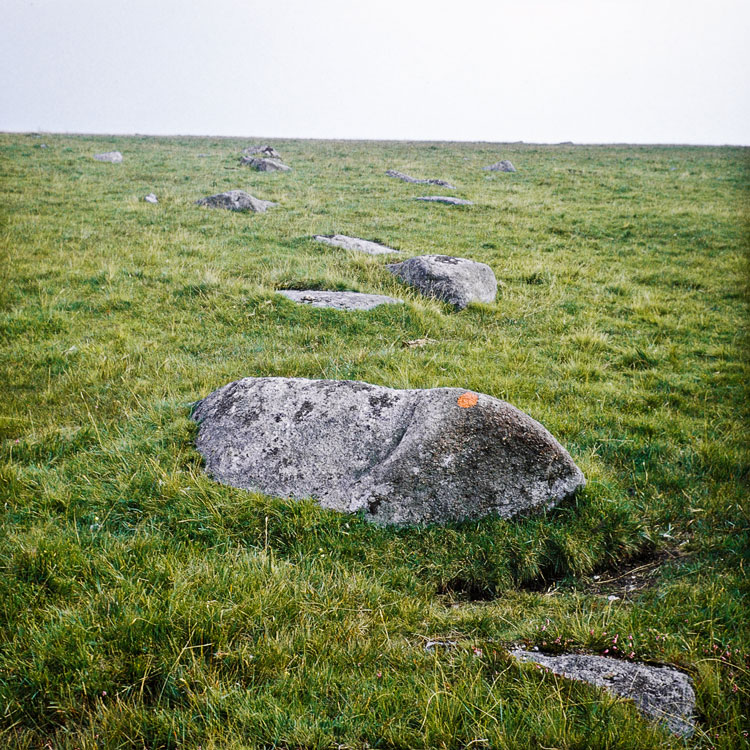
Nancy Holt, Trail Markers, 1969, printed 2012. (Dartmoor, RAMM, Exeter, 2024) © Holt Smithson Foundation, Licensed by Artists Rights Society, New York.
,-1969,-printed-2012.jpg)
Nancy Holt, Wistman's Wood (detail), 1969, printed 2012. (Dartmoor, RAMM, Exeter, 2024). © Holt Smithson Foundation, Licensed by Artists Rights Society, New York.
The work of Long is another major presence in this show with 11 works from 1971 to 2011 demonstrating his long engagement with landscape through walking, often using photography with overlaid text. One of the later works included here is Five Ways (Diptych) Dartmoor (2006), a work made in response to five walks and the artist’s quiet presence in the landscape. Long explains that his work “is just about being a human being living on this planet and using nature as a source. I enjoy the simple pleasures of … eating, dreaming, happenstance, of passing through the land and sometimes leaving [memorable] traces along the way, of finding a new campsite each night. And then moving on.” Long’s respect and care for the landscape is evident in these words and in his work.

Garry Fabian Miller, The Darkroom’s Fading Presence, 2020. (Dartmoor, RAMM, Exeter, 2024). © Garry Fabian Miller, RAMM.
The use of dye destruction prints by artists such as Susan Derges and Miller is utterly fascinating to see. Miller’s large-scale print Breathing in the Beech Wood, Homeland, Dartmoor, Twenty-Four Days of Sunlight (2004) is exquisite in its exploration of photosynthesis in trees. Gathering beech leaves from his garden over a 24-day period, the artist then printed in the darkroom by shining light through the leaves, projecting and recording the leaf images directly on to photosensitive paper at a single moment in their cycle of photosynthesis. In this way he created a leafy grid entirely without a camera. Miller works from his home-studio on Dartmoor and imagines an eight-mile-wide circle around his home, marking out an area he thinks of as The Crucible. It is within this space that he lives and works, walking through and across on a daily basis and experiencing and responding to what he encounters there. There is a sense of a life lived meditatively in this landscape, one in which Miller looks outward and acutely observes the natural world around him, searching for clues, perhaps, about human existence.
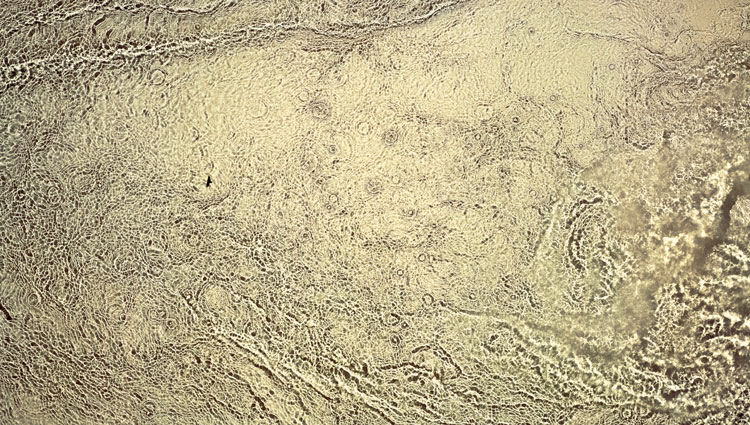
Susan Derges, Eden 6, 2004. (Dartmoor, RAMM, Exeter, 2024).
Derges also uses camera-less photography in her work with three monumental photograms from her Eden series of 2004 representing the artist in this exhibition. Interested in the relationship between the self and nature, and working out of doors at night, Derges feels her photograms of water, “can offer a visual and metaphorical means of articulating the inner qualities of mind, psyche or soul that exist in relation to our experience of the outside world”. Working on a short section of the River Taw at Skaigh Valley on a single night, the images included here are part of a larger series examining the hydrological cycle, a process dependent on weather and the cycles of the moon as they affect the flow of the river.
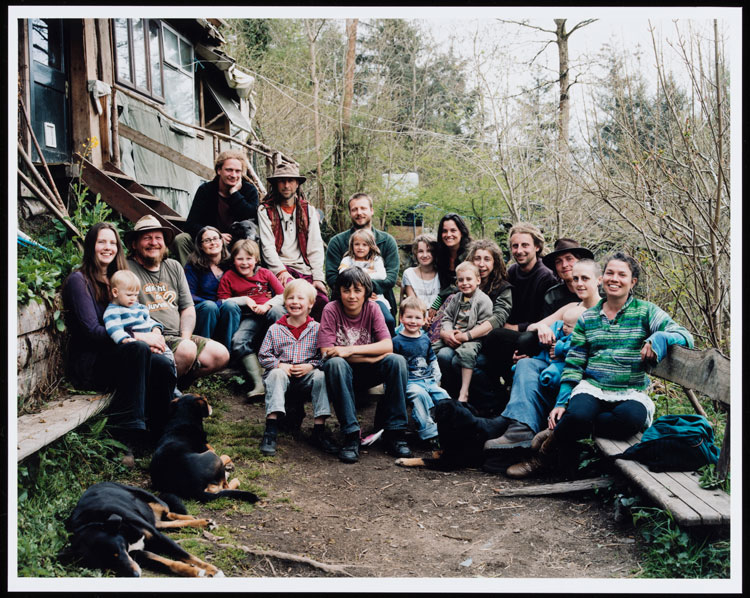
David Spero, Community portrait, April 2010, 10th Anniversary, 2010. (Dartmoor, RAMM, Exeter, 2024). © David Spero, Victoria and Albert Museum, London.
All the artists discussed so far engage directly with the land in one way or another. Others consider how it is used, for protest, community, foraging and camping. David Spero’s Settlements project (2004-ongoing) documents the Steward Community Woodland on the very edge of Dartmoor where the community constructed dwellings, grew food, and generated electricity. Spero’s photographs of this quiet act of protest are filled with warmth. As he explained in 2015: “To build and live in a low impact settlement transforms the act of protest into a more holistic form, to a living demonstration of what is possible – pushing boundaries, stretching and challenging the imagination. It creates spaces where alternatives can be traced out and given room to evolve and grow.”
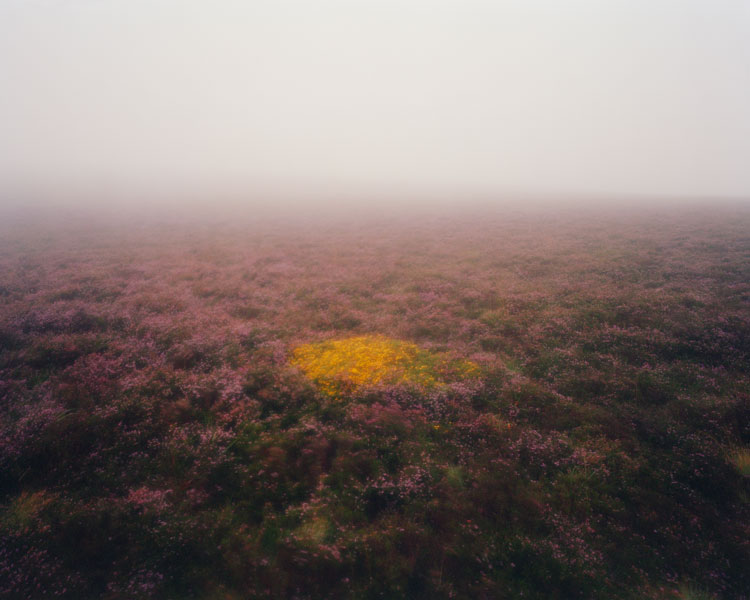
Nicholas JR White, Gorse in Heather from the Crucible series, 2020. (Dartmoor, RAMM, Exeter, 2024). © Nicholas JR White.
In this way, what he documents give hopeful possibilities for the future of the planet and humankind. This may seem a somewhat idealistic stance, or observation, but it is a record of the activities of ordinary people, trying to find new and sustainable paths forward, challenging themselves and engaging with Dartmoor head on. Darch’s sympathetic and perceptive photographs document a group of young people aged 14 to 19 as they train for the Ten Tors Challenge on Dartmoor. Revealing something of their tenacity and endurance in navigating harsh weather and the inevitable bodily exhaustion, these photographs capture the quiet strength of these young people as they face a demanding physical and mental challenge.
.jpg)
Alex Hartley, The Summoning Stones, (Dartmoor 2024). © Alex Hartley.
The two commissioned artists in this exhibition take very different approaches in their response to the spaces of Dartmoor. Hartley’s installation The Summoning Stones (2024) provides a wraparound environment for the visitor and an opportunity to experience the power of neolithic stone through their representation in the gallery as prints on and in recycled solar panels. The artist admits it is almost certainly an unachievable goal, but it remains an admirable attempt to bring the power and mystery of Dartmoor into the gallery.

Ashish Ghadiali, Cinematics of Gaia and Magic 3, 2024. Film still. © Ashish Ghadiali.
A video by Ghadiali (the other commissioned artist), Can You Tell the Time of a Running River? (2024), is a mesmerising installation inspired by the artist’s conversation with Gaia theorist James Lovelock. Gaia theory proposes that living organisms interact with their inorganic surroundings to create a self-regulating system maintaining the conditions for life on the planet. With a hypnotic sound track, Ghadiali’s film juxtaposes the flow of the river Dart with his thrice entering a fast-moving pool and exploring different temporalities. It is a gentle and generous film and, whatever you may think about Gaia, it is a healing film that, like the rest of the work in this exhibition, proposes new ways of being in the landscape that encounter, challenge, heal and sustain. The ideal would be to experience Dartmoor first-hand, but this exhibition is surely the next best thing. From the work of Holt and others in 1969, through more than half a century to new work made just this year, it is a testament to Dartmoor’s enduring potential to sustain and inspire human and non-human activities of all kinds.